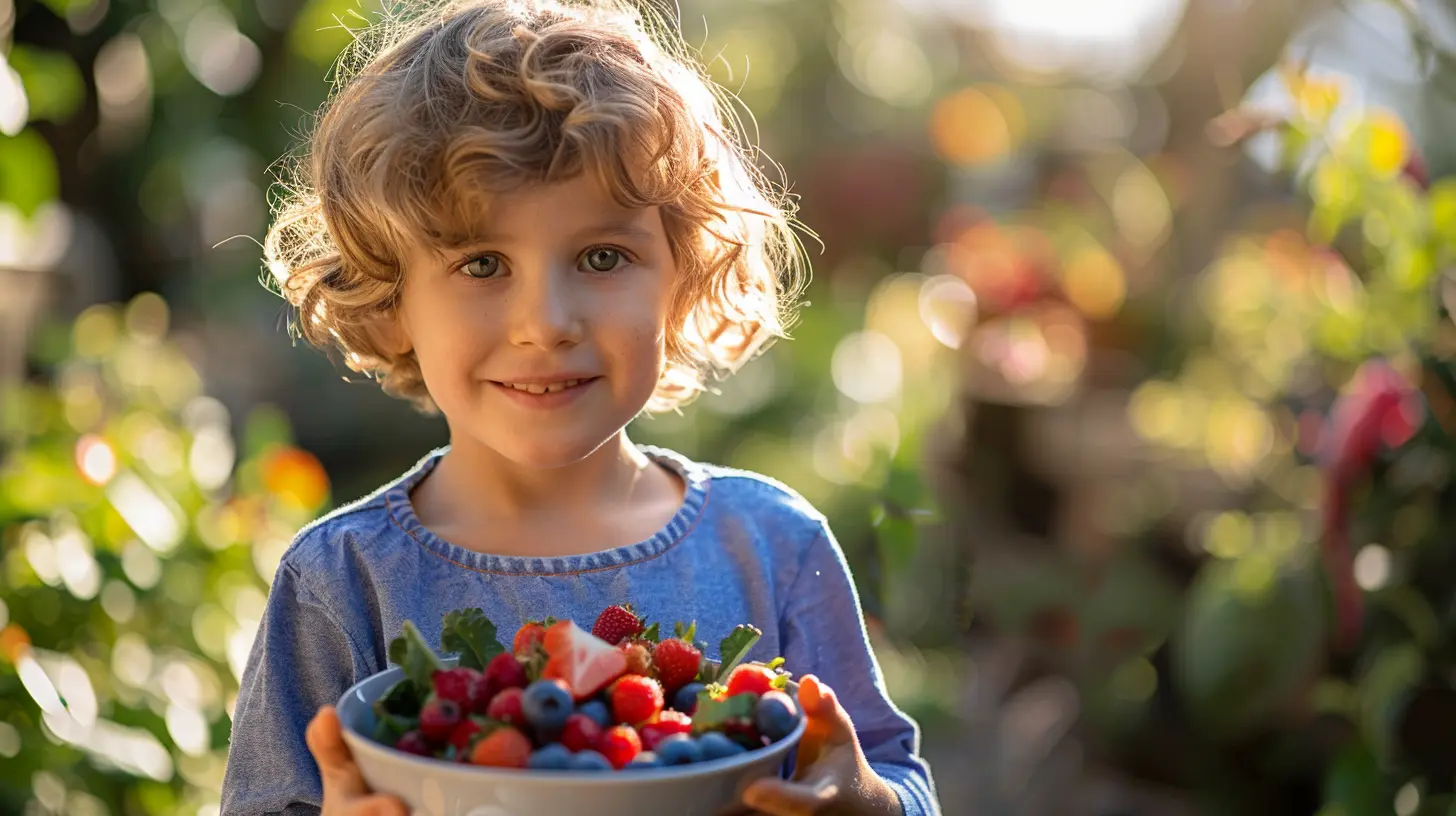Managing Screen Time and Snacking: Keeping Kids Healthy
16 August 2025
Okay, let’s be honest—parenting in the digital age is…a lot. Screens are everywhere. Tablets, smartphones, laptops, TVs—you name it. And while that cartoon marathon or YouTube binge can buy you a bit of sanity (we’ve all been there), it often comes with side effects: like those mysterious snack wrappers scattered on the couch.
Managing screen time and snacking might feel like juggling while riding a unicycle, but here’s the good news: with a little planning and a lot of love, you can absolutely help your kids develop healthier habits. Let’s dive deep into why this matters and, more importantly, how to make it work for your family—without pulling your hair out.
Why Screen Time and Snacking Go Hand-in-Hand
Have you ever noticed how your child becomes a bottomless pit the moment a screen turns on? One episode in, and suddenly they’re “starving” for chips, cookies, and whatever else they can dig out of the pantry.It’s not just your kid—this is super common. When children are glued to screens, they're less aware of their body's hunger cues. Plus, let's be real, snacking while watching TV feels like a treat. It becomes a habit fast: screen time = snack time.
The Sneaky Impact on Health
The combo of excess screen time and mindless snacking is kind of like pairing soda with candy—it’s a recipe for trouble. Here’s why:- Weight gain and obesity: More sitting + more calories = not great.
- Poor sleep habits: Screens (especially before bed) mess with melatonin.
- Reduced physical activity: Less time for active play.
- Mindless eating habits: Kids eat without realizing how much or why.
You probably already know this, right? But breaking the cycle is easier said than done. So let’s talk solutions.
Setting Healthy Screen Time Boundaries (Without the Tantrums)
Nobody wants a meltdown over turning off Paw Patrol. But setting limits doesn’t have to be a battle. The key is consistency—and a little creativity.1. Create a Screen Time Schedule
Make screen time part of the daily routine, just like brushing teeth. For example:- Morning: Limited to 30 minutes after breakfast.
- Afternoon: A show or two after schoolwork.
- Evening: None an hour before bed.
Having a predictable structure helps kids know what to expect—and gives you an easy answer when they beg for “just ten more minutes.”
2. Use Tech to Fight Tech
There are tons of apps and tools that help manage screen time. Whether it’s built-in parental controls or third-party apps like Qustodio or Bark, these can help give you back some control without being the screen-time police.3. Model the Behavior You Want
Yep, that means putting your phone down too. Kids learn more from what we do than what we say. If they see you scrolling through social media at dinner, they're going to think it’s okay for them to do the same.
Turning Screen Time Into Quality Time
Not all screen time is created equal. It’s one thing if your child is watching unboxing videos for an hour; it’s another if they’re learning math with an educational app.1. Choose Educational Content
Look for shows, games, and apps that promote learning, creativity, and problem-solving. Common Sense Media has great reviews and age-based suggestions.2. Watch Together
Make screen time interactive. Ask questions, discuss storylines, and get involved. It's screen time, sure—but it's also bonding time.3. Create Alternatives
Boredom often leads to screens. So instead of just saying “no,” offer a “yes, but.”- “No tablet right now, but you can build with Legos.”
- “Let’s do a puzzle together instead.”
Every “no” needs a “yes” that feels even better.
Tackling Mindless Snacking Head-On
Now for the other half of the equation: snacks.Snacking isn’t the enemy, but how and what kids snack on makes all the difference.
1. Create a Snack Schedule
Just like screen time, having set snack times helps kids listen to their hunger cues.Try:
- Mid-morning snack
- Afternoon snack
- Optional small evening snack (if dinner was early)
No endless grazing throughout the day, especially not in front of screens.
2. Keep Healthy Options Within Reach
If junk food is easy to grab, guess what your kids will go for? Stock the pantry and fridge with snacks that are both tasty and nutritious:- Sliced fruits & veggies
- Yogurt
- Cheese sticks
- Whole grain crackers
- Nuts and seeds (if age-appropriate)
Set up a “snack zone” in the fridge so your kids know their go-to shelf.
3. Portion Control Is Key
Even healthy snacks can pile on the calories if eaten mindlessly. Use small bowls or containers to help manage how much your kids eat. Bonus: no more chip bags disappearing in one sitting.Linking Movement to Screen Time—Yes, It’s Possible!
Let’s face it. Kids love screens. But what if we could use that love to encourage more movement instead of less?1. Active Tech Games
Think Just Dance, Wii Sports, Ring Fit Adventure, or even beginner yoga videos on YouTube. These combine screen time with actual physical activity—and they’re SO fun.2. Commercial Break Workouts
If your child is watching traditional TV, use the ad breaks as mini movement sessions:- 10 jumping jacks
- A sprint around the house
- Stretching
Make it silly. Add a timer. Challenge them to a dance-off!
Making Mealtimes Sacred Again
Family meals? They're not just for Instagram. Eating together without screens helps build healthy eating habits and actually encourages conversation (remember that?).1. No Screens at the Table—Ever
Make it a rule, for everyone. Yes, that includes you. Your emails can wait until the plates are clean.2. Talk About the Day
Use mealtime to connect. Ask about highs and lows, what made them laugh, or who they sat with at lunch.3. Involve Kids in Meal Prep
Kids are way more likely to eat something if they helped make it. Give them simple tasks: mixing ingredients, choosing a veggie, or setting the table.Back to Basics: Sleep, Play, and Real Life Interaction
Screens and snacks are just part of the picture. A healthy lifestyle means looking at the whole child.1. Prioritize Sleep
Screens before bed? Major no-no. The blue light delays melatonin and messes with sleep. Create tech-free wind-down routines like reading, puzzles, or listening to calming music.2. Outdoor Time Is Essential
Kids need sunlight and dirt. Period. Whether it's the backyard, park, or a walk around the block, aim for at least 1 hour of outdoor play every day.3. Real-Life Social Skills
Yes, online games with friends are fun—but they can’t replace real-world interactions. Encourage playdates, team sports, or even good ol’ fashioned hide-and-seek.When It All Goes Off the Rails (Because It Will)
Let’s be real for a second. You’re not going to get it perfect every time. Some days, your kid will watch too much. Other days, they’ll snack like they’re prepping for hibernation.And that’s okay.
The goal isn’t perfection—it’s progress. What matters is building awareness, creating structure, and doing your best to model better choices.
Every step counts.
Building Family Habits That Stick
Here’s the bottom line: screens and snacks aren’t going anywhere. But by setting routines, modeling healthy behaviors, and keeping habits positive and fun, you can absolutely navigate this modern parenting tightrope.And when you slip? Just climb back on.
You’ve got this.
Quick Tips Recap (For the Parents Who Skim—No Judgment!)
- Create screen and snack schedules- Set clear rules (and follow them as a family)
- Offer fun alternatives to both screen time and junk food
- Make meals and movement part of everyday routines
- Use tech tools to stay on track
- Most importantly—be kind to yourself
all images in this post were generated using AI tools
Category:
Kids NutritionAuthor:

Liam Huffman
Discussion
rate this article
1 comments
Caden Banks
Great insights in this article! Balancing screen time and healthy snacking can be tough, but it's crucial for our kids’ well-being. Setting clear boundaries and encouraging outdoor activities can make a big difference. Thanks for sharing practical tips to help us navigate this challenge!
August 27, 2025 at 4:09 AM

Liam Huffman
Thank you! I'm glad you found the tips helpful. Balancing screen time and healthy habits is indeed essential for our kids’ well-being!


